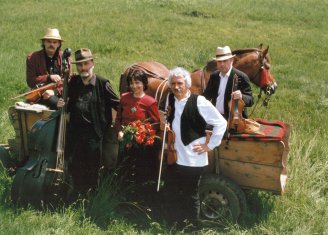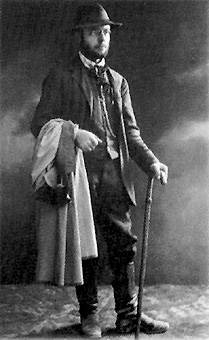MUZSIKÁS
On the routes of Béla Bartók

MUZSIKÁS
On the routes of Béla Bartók

Bartók is
acknowledged worldwide as one of the most important and influential musical
personalities of the century. The majority of his works exhibit the influence of folk music.
While he forged a twentieth century modern musical language, he also used melodies,
melodic shapes, harmonies and rhythms which he encounted on his own
collecting trips, and during his subsequent work writing this material down. At the
beginning of this century, the peasant country people, who preserved a rich tradition of
music, folk song and dance, lived worlds apart from the middle class to which
Bartók himself belonged. Bartók wrote that "In the so-called cultured urban circles, the
unbelievably rich treasure trove of folk music was entirely unknown. No one even suspected
that this kind of music existed."
In the nineteen fifties, the study of folk dance
received a new impetus with the invention of portable cameras and sound recorders. A new
generation immersed itself enthusiastically in the task of "mapping" the traditions of
Hungarian language territory. This was achieved under the guidance of György
Martin, who emulated Bartók's own ideal of deep scholarship. The modern study of
folkdance was born, which looked at the structural properties of Hungarian dances, their
types and regional variations, and also made comparisons with the dance traditions
of neighbouring peoples. The filming also brought about the discovery of large quantities
of dance music, which was still virtually unknown, from the archaic territory of Hungary,
principally Transylvania. The great contributor in this field was Zoltán
Kallós. The result of the new technology was that longer musical performances, including
the accompanying music for large dance cycles, could be recorded. This was something that
was not possible at the start of the century for technical reasons. In
the 1970s, a new wave of interest in folk art swept Hungary. Part of this was an interest in
folk dance and music traditions. The new generation wanted to experience these traditions
at the source, stripped of the accretions that non-authentic
interpretations tended to add. We, the members of the Muzsikás group began our studies
during this period. We also would go on collecting trips into the countryside, armed with
cameras and taperecorders. But our principal aim was to learn the
instrumental techniques from village musicians. Dancers did the same. We all found
ourselves fascinated by the power of traditional folk art. György Martin enthusiastically
supported us. He supplied us with his own recordings, and gave the dance
house movement the necessary scholarly background. Something akin to a new lifestyle
evolved in the clubs and cultural centres. It became known as the Dance House Movement,
and it provided informal opportunities for people to learn folk music and
dances. It also became a means for self-expression. Folk music was heard outside the clubs
as well, on the stage, and on records.
The Muzsikás group quickly became a performing
band. In this way, we played in concert halls all over Europe and the
world. On one occasion, we were invited to New York for the Bard College music festival.
The theme of the festival was Bartók's music. Although the audience knew Bartók's music
well, most were hearing folk music for the first time. It was then that
we decided to make a record which would demonstrate the relationship between Bartók and
Folk Music. Almost every melody on Muzsikás' Bartók album was originally collected by
Bartók himself. He also wrote these melodies down and used them in his own
works. We want to show this side of Bartók, Bartók the collector. We do not aim to
produce something for the library catalogues, rather we wanted to make something like
Muzsikás' other recordings. We conceive of it as having three strands: you can
hear the original phonograph recordings, which inspired three violin duos which also feature
on the CD. Behind the scratchy recordings is the man, the sound, which captivated Bartók.
The duos are performed by Mihály Sipos, of Muzsikás, and the Romanian
born classically trained violin virtuoso Alexander Balanescu. We have been friends with him
for many years, and he has played the duos before. "Now, when I work with the Muzsikás
ensemble, I feel that something important is happening to me. If can
feel just how important for me is the cultural background against which I grew up, the area
from where I come, where I grew up and where I studied." (Alexander Balanescu) Finally,
we hear Márta Sebestyen, who has performed with the orchestra almost from
its very beginning, and has herself a superb knowledge of ancient folk singing styles. She
can reproduce with sensitivity and authenticity the sound of the singers that Bartók heard in
the villages, and who he recorded with his phonograph. Together
with the Muzsikás group, you can hear the vocal and dance melodies that Bartók could hear
during his collecting trips at the start of the century. And we ourselves learned to play by
studying village musicians. We are joined by dancer Zoltán Farkas and
choreographer, Ildikó Tóth in some numbers - you will be able to hear them dancing
sometimes. In our CD, we are searching for the answer, what is it in folk music, that
attracted Bartók like a magnet? It is a question that applies perhaps equally to
ourselves.
 Bartók collected in virtually every
area where the Hungarian language was spoken. During the course of
his travels, he became acquainted with instrumental music and dance traditions. His
experiences with the ancient and yet unique folk cultures of Transylvania and his observations
of the relationship between the different ethnic groups fueled his own
philosophy of life, best summarised in his much quoted remark: "My guiding philosophy has
always been the ideal of different nations uniting into brotherhood, inspite of all the wars and
hostility. I have tried to serve the aims of this idea, as best as
I can, in my music, so for that reason, I do not shrink away from any influence, be it
Slovak, Romanian, Arab or any other source." In 1919, Bartók felt that the final hour had
come for folk music collecting. Against expectations, the tradition proved
itself much stronger. Bartók and Kodály's successors were still uncovering valuable material
many decades later. And slowly, the cataloging and scholarly study of Hungarian folk
material began.
Bartók collected in virtually every
area where the Hungarian language was spoken. During the course of
his travels, he became acquainted with instrumental music and dance traditions. His
experiences with the ancient and yet unique folk cultures of Transylvania and his observations
of the relationship between the different ethnic groups fueled his own
philosophy of life, best summarised in his much quoted remark: "My guiding philosophy has
always been the ideal of different nations uniting into brotherhood, inspite of all the wars and
hostility. I have tried to serve the aims of this idea, as best as
I can, in my music, so for that reason, I do not shrink away from any influence, be it
Slovak, Romanian, Arab or any other source." In 1919, Bartók felt that the final hour had
come for folk music collecting. Against expectations, the tradition proved
itself much stronger. Bartók and Kodály's successors were still uncovering valuable material
many decades later. And slowly, the cataloging and scholarly study of Hungarian folk
material began.